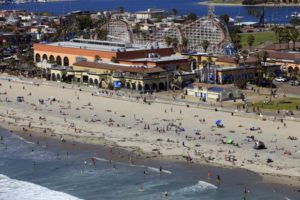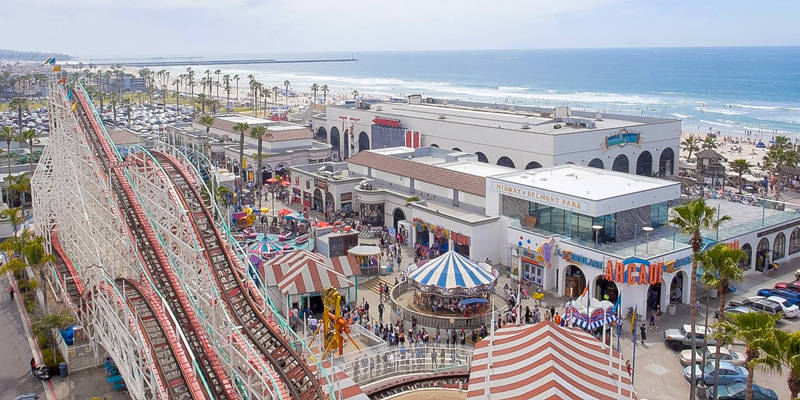Belmont Park/Wave House/Draft South Mission.https://www.belmontpark.com/The entire project was the idea of sugar magnate, John D. Spreckels, a major force in San Diego’s development.The 2,600 ft. long coaster was built in less than two months with a crew of between 100 and 150 workers. The original cost to build the coaster was $50,000, which included two, 18 passenger trains.The Mission Beach Amusement Center, as it was known, was popular through the 1930’s and 40’s and in later years it was renamed, Belmont Park. Back then, the Giant Dipper Roller Coaster was an extremely popular attraction. But by the late 60’s and early 70’s Belmont Park fell into disrepair and the park and coaster finally closed in December 1976.After surviving several fires, peeling paint and becoming the home for local transients, the owner of the coaster was under a lot of pressure to have it torn down and the demolition date was set. A group of concerned citizens called “Save The Coaster Committee,” had the coaster designated as a National Landmark and asked that the ownership be transferred to them. By doing so, they saved the roller coaster and are responsible for ensuring that the Giant Dipper Roller Coaster exists today for future generations to enjoy. The committee was given a preservation grant, raised funds locally, and donated their time to work on the coaster, unfortunately, they were not able to raise the amount needed to restore the coaster to an operating condition.In 1989, the developer of the new Belmont Park retail specialty center contacted the Santa Cruz Seaside Company to see if they might have some interest in restoring and operating the Belmont Park Roller Coaster. The Santa Cruz Seaside Company is the owner and operator of the Santa Cruz Beach Boardwalk amusement park.After a year of discussions the City Council of San Diego approved a long-term lease. A new company, The San Diego Seaside Company was officially formed to restore and operate the Giant Dipper. Over $2,000,000.00 was spent on the restoration of the Giant Dipper and one new train that was built. The new train had six, 4-person cars.The newly restored, historic roller coaster was reopened to the public on August 11, 1990. The response by the public was overwhelming. The restored structure, station house and train were beautiful. Local residents who had ridden the roller coaster years earlier brought their spouses and children to see and experience the ride that they had ridden when they were growing up. Annual ridership on the Giant Dipper in the first year was three times the original projections.The nostalgic look of yesterday and the strict safety standards of today are combined in Belmont Park’s Giant Dipper, along with a strong sense of historical integrity.The Mission Beach Plunge opened in May, 1925 as the centerpiece of Belmont Park. The 60′ by 175′ pool was, at the time, the largest salt-water pool in the world, holding 400,000 gallons of water. The building encapsulating The Plunge was designed after the Spanish Renaissance style buildings that were erected in San Diego’s Balboa Park between 1915 and 1916.Other than the Giant Dipper roller coaster, also located at the Belmont Park, The Mission Beach Plunge is the only remaining structure to survive from the original Belmont Park. It’s had over 1 million people learn to swim in its pool, including celebrities such as Esther Williams and Johnny Weissmuller.Eventually in 1940, when the salt-water began to damage the filter system in the pool, fresh water was brought in and The Plunge became “The largest indoor heated pool in Southern California,” at 12,000 square feet. The pool continued to run smoothly, but was closed in April of 1987 due to failed city earthquake and fire requirements.This closure applied to the entire park, including The Giant Dipper, the roller coaster featured in Park, as well as all retail centers located throughout the remainder of the property. The Plunge, as well as the remainder of Belmont Park under went some major renovation and eventually the 12,000 square foot Plunge reopened in the summer of 1988 with a whole new look. Though The Plunge endured many modifications, certain features historic to the pool were rescued and allowed to stay, such as the steps into the pool and the pedestal, located at the bottom of the steps. Currently the Plunge is closed due to lack of funds. No one is sure when it will reopen again.
A group of concerned citizens called “Save The Coaster Committee,” had the coaster designated as a National Landmark and asked that the ownership be transferred to them. By doing so, they saved the roller coaster and are responsible for ensuring that the Giant Dipper Roller Coaster exists today for future generations to enjoy. The committee was given a preservation grant, raised funds locally, and donated their time to work on the coaster, unfortunately, they were not able to raise the amount needed to restore the coaster to an operating condition.In 1989, the developer of the new Belmont Park retail specialty center contacted the Santa Cruz Seaside Company to see if they might have some interest in restoring and operating the Belmont Park Roller Coaster. The Santa Cruz Seaside Company is the owner and operator of the Santa Cruz Beach Boardwalk amusement park.After a year of discussions the City Council of San Diego approved a long-term lease. A new company, The San Diego Seaside Company was officially formed to restore and operate the Giant Dipper. Over $2,000,000.00 was spent on the restoration of the Giant Dipper and one new train that was built. The new train had six, 4-person cars.The newly restored, historic roller coaster was reopened to the public on August 11, 1990. The response by the public was overwhelming. The restored structure, station house and train were beautiful. Local residents who had ridden the roller coaster years earlier brought their spouses and children to see and experience the ride that they had ridden when they were growing up. Annual ridership on the Giant Dipper in the first year was three times the original projections.The nostalgic look of yesterday and the strict safety standards of today are combined in Belmont Park’s Giant Dipper, along with a strong sense of historical integrity.The Mission Beach Plunge opened in May, 1925 as the centerpiece of Belmont Park. The 60′ by 175′ pool was, at the time, the largest salt-water pool in the world, holding 400,000 gallons of water. The building encapsulating The Plunge was designed after the Spanish Renaissance style buildings that were erected in San Diego’s Balboa Park between 1915 and 1916.Other than the Giant Dipper roller coaster, also located at the Belmont Park, The Mission Beach Plunge is the only remaining structure to survive from the original Belmont Park. It’s had over 1 million people learn to swim in its pool, including celebrities such as Esther Williams and Johnny Weissmuller.Eventually in 1940, when the salt-water began to damage the filter system in the pool, fresh water was brought in and The Plunge became “The largest indoor heated pool in Southern California,” at 12,000 square feet. The pool continued to run smoothly, but was closed in April of 1987 due to failed city earthquake and fire requirements.This closure applied to the entire park, including The Giant Dipper, the roller coaster featured in Park, as well as all retail centers located throughout the remainder of the property. The Plunge, as well as the remainder of Belmont Park under went some major renovation and eventually the 12,000 square foot Plunge reopened in the summer of 1988 with a whole new look. Though The Plunge endured many modifications, certain features historic to the pool were rescued and allowed to stay, such as the steps into the pool and the pedestal, located at the bottom of the steps. Currently the Plunge is closed due to lack of funds. No one is sure when it will reopen again.



